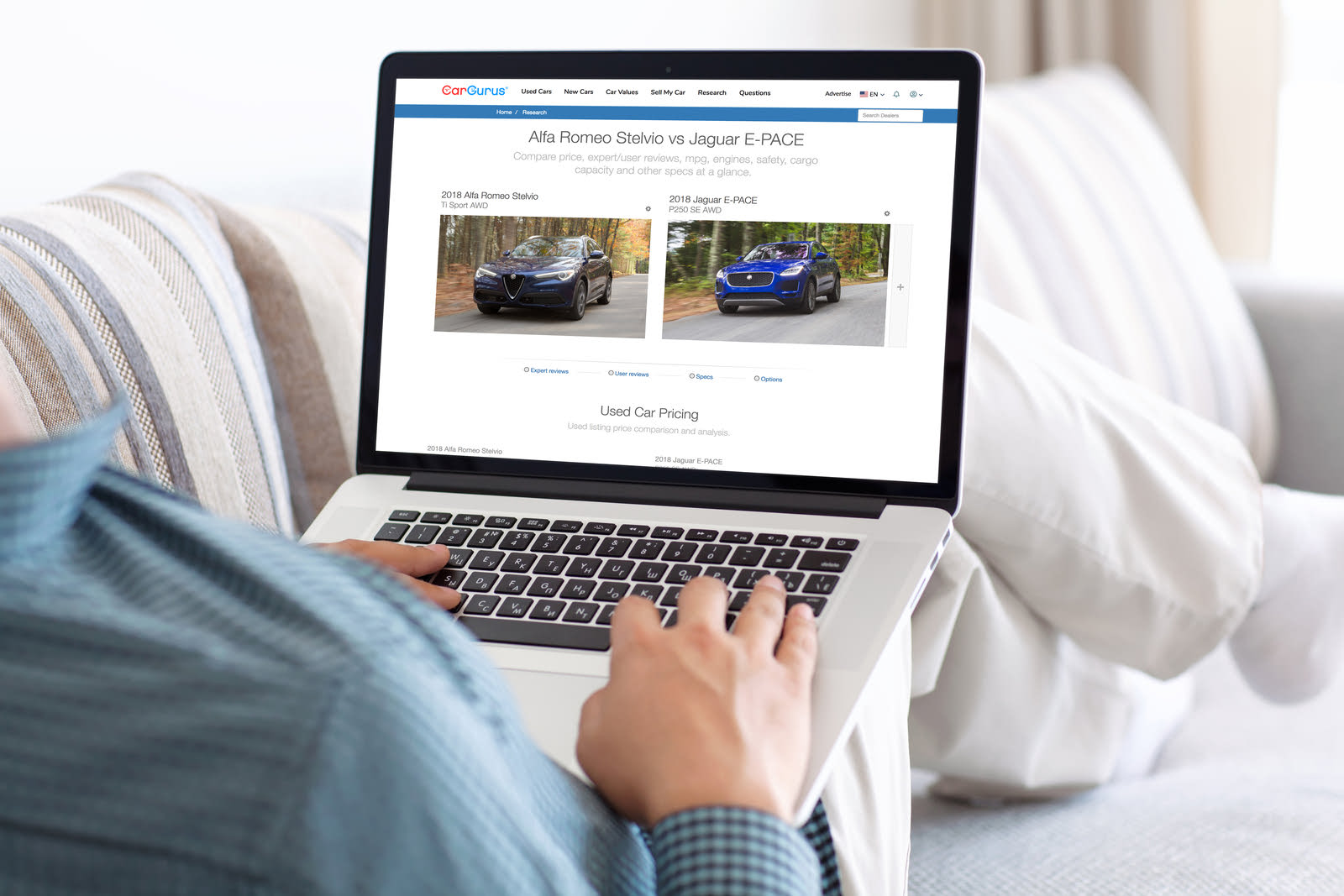It’s time to get a new car. You’ve weighed the pros and cons, considered the marketplace, and are on the hunt for that perfect used car. The world is a scary place, however, and the world of used cars can be particularly daunting. To help put your mind at ease, we’ve compiled a list of ten tips for buying a used car everyone should take when going through the buying process.
How To Buy a Used Car
Researching a Used Car
Budgeting for a Used Car
Inspecting and Test Driving a Used Car
Negotiating and Closing the Deal
Researching a Used Car
Tip 1: Determine the vehicle’s market value
With a budget in mind and your recently acquired wealth of knowledge, it’s time to find the right car for you. The CarGurus Used Car search engine will allow you to search for cars by make and model, body style, or pricing, and your search results will not only feature the CarGurus Instant Market Value analysis, but they'll also automatically rank by our deal rating. This means no more sifting through pages and pages of listings, trying to make sense of trim levels, options, and asking prices: CarGurus does that for you.
When determining a specific car’s value, condition is key. Certain brands and models may have higher resale value, but that varies depending on what shape a given car is in, and the amount of miles on the odometer. Low-mileage cars command higher prices. Consulting with resources like Kelley Blue Book can be helpful to give you a baseline, so you can see if the price quoted by a salesperson or individual seller is off the mark.
Tip 2: Look up reviews
As you narrow your search, don't forget to research each potential purchase by reading expert reviews. From performance to safety and from technology to cost-effectiveness, CarGurus Expert Reviews can help you figure out exactly what make, model, and trim vehicle is right for you.
Use the filters found on the results pages to find cars that fit your criteria. You’ll be able to select specific trims, colors, and even transmissions and drivetrains. Want a green crossover with all-wheel drive and an automatic? CarGurus can help.
Once you’ve found your perfect car, take a look at the description, read other shoppers’ reviews of the dealership, and use the blue “Contact Dealer” form on that page to submit an inquiry. CarGurus will notify the dealer of your interest, and you should hear back soon!
Budgeting for a Used Car
Tip 3: Consider your total cost of ownership
While researching a used car purchase, you’ll also need to consider your budget. There are three critical elements to a good car budget: down payment, interest rate, and monthly payment. It’s very easy to fall into a habit of budgeting for a car based on monthly financing payments, and a monthly payment is likely the number that will be most often thrown around once you do sit down to negotiate. But at this stage in the game, you want to budget for the maximum purchase price of your new car. You may plan to trade in your current vehicle, but until you know which dealer you'll work with and how they'll determine your trade-in value, it's best to exclude that from budget considerations.
Typically, you’ll need to put down at least 10% of the car’s purchase price as a down payment. This means that if you’re looking at a $20,000 truck, you should expect to put down at least $2,000 up front. Every dollar you put down is a dollar you don’t have to pay interest on when it comes time to finance, however, so if it’s within your means, you should feel encouraged to put down more than 10%—just don’t get too carried away.
If you’re buying an especially used vehicle, you’ll also want to keep an “emergency fund” on hand to handle unexpected (but generally inevitable) repairs. Don’t spend your entire budget on your initial purchase, and keep in mind that higher-end vehicles will almost always cost more to repair than more value-oriented cars. Some automakers offer certified pre-owned vehicles (CPO) with a factory warranty, and it may be possible to purchase an extended warranty, but don’t expect as much coverage as a new car.
Tip 4: Shop around for financing
It’s also important to research financing before heading to a dealership. Shopping around with different financial institutions will help you find the best loan terms, and save time at the dealership when purchasing a used vehicle.
Most car dealerships offer in-house financing, but that’s not your only option. Banks and credit unions offer auto loans as well, often with the ability to get a quote online. These institutions often allow you to borrow up to 120% of the purchase price, which lets you cover sales tax with the loan amount, too. It’s necessary to factor those costs in when determining the out-the-door price of a used car.
Shopping around for financing allows you to compare offers, in all cases creditworthiness will impact loan terms, with fewer good options for those with bad credit. Checking your credit score ahead of time is a good idea, to know where you stand. Used-car loans in general also tend to have higher interest rates than loans for new vehicles. That’s due in part to the higher resale value of new cars, as well as the lack of incentives from both automakers and dealerships compared to new cars.
Inspecting and Test Driving a Used Car
Tip 5: Test drive during the day
Finally, finally, it’s time to take cars for test drives. By this point, you’ve probably identified which car is your first choice, but it’s always a good idea to drive more than one vehicle when you’re making a final decision. This will give you an opportunity to weigh one car’s strengths and weaknesses against another’s, and see whether previous owners have taken care of them.
This should absolutely be done during the day so that you can clearly see any damage or decay, such as dents, scratches, or rust, and adjust your price calculations accordingly. A daytime test drive will also make it easier to check the condition of the tires, which you should do simply in the name of safety before getting behind the wheel of an unfamiliar vehicle with an unknown amount of wear and tear.
Driving during the day is also a bit less stressful than driving at night, so you’ll be able to focus completely on evaluating the car and looking for potential issues. Speaking of which…
Tip 6: Listen for unusual noises
Not every issue will become apparent during a test drive, but unusual noises are an important tell. They can indicate something minor like a loose piece of plastic trim, or something more serious. For example, squeaking sounds when decelerating or steering wheel shudder indicate that the car needs its brakes serviced. An extra-loud engine could point to a muffler that needs replacing.
Tip 7: Get a vehicle history report
Most dealers will be willing to provide a vehicle history report—CarFax and AutoCheck are the two most common—and there’s no point in test-driving a car without one. Vehicle history reports are only as good as their data, so while a spotless one might not put you 100% in the clear, a bad one can steer you away from purchasing a lemon. If you’re buying a car from a private seller, you may need to track down these reports yourself by running the vehicle identification number (VIN).
Also, ask the dealership or seller if they have any reservations about taking the car to an independent mechanic for an inspection. Anyone selling a well-sorted vehicle shouldn’t take issue with this request, although it’s not uncommon for the dealer to request a deposit before allowing you to take the car for a mechanical inspection. Remember how a clean vehicle history report doesn’t guarantee a perfect car? Well, that’s where the inspection comes in. For about $100 (which you’ll pay, not the dealership), a good mechanic can provide the peace of mind that a CarFax simply can’t. If the dealer or private party refuses to let you have the car inspected, consider it a red flag.
Negotiating and Closing the Deal
Tip 8: Remember your research
Once you’ve done your due diligence, it’s time to talk turkey. You’ll be in a more comfortable negotiating position if you enter negotiations having already secured financing options, like pre-approval from an outside lender.
Keep in mind that starting significantly below the manufacturer's suggested retail price (MSRP)may lead to a dead end. Pitch a respectful offer and make sure the dealership understands that you’ve done your research to identify the best price. Car dealers stand to make money on more than just the purchase price of a vehicle, so a willingness to buy some of the add-ons like floor mats or rustproofing may entice them to go lower than they typically would.
Tip 9: Negotiate the total price
All dealers will add taxes and fees to the final sales price. It can be frustrating for car buyers, but these fees generally aren’t worked into the advertised price of the car. However, this is rarely an attempt by the dealership to pad its bottom line, and it shouldn’t be considered out of line.
Tip 10: Be prepared to walk away
If negotiations aren’t going your way, walking away is always an option. Even if you need a car badly, it’s not worth agreeing to a bad deal. The long-term effects, whether it’s paying an MSRP above market value, or getting stuck in a loan that’s too long, or with too high a monthly payment or interest rate, will negate any short-term benefit of a hastily made deal. Being prepared to walk away lets you negotiate from a position of strength so that you don’t have to make a deal you might regret later.
Related Topics
Everything You Need to Know About Certified Pre-Owned Cars
Who to Expect at a Car Dealership
Why Every Used-Car Shopper Should Check Vehicle History Reports




